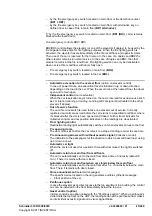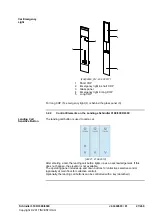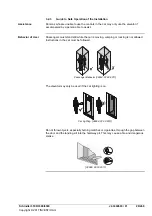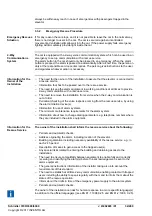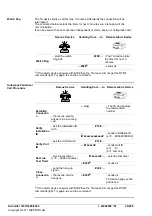
Schindler 3100/3300/6300
J 43402603 / 01
22/269
Copyright © 2017 INVENTIO AG
Safety Components
The safety gear (13) on the car stops the car (11) if it travels downward at excessive
speed. The safety gear (13) is tripped by the overspeed governor (9).
The safety gear (15) (optional) on the counterweight, if provided (see characteristics),
stops the counterweight if it travels downward at excessive speed. The brake (6) on the
motor stops the car if any of the safety switches activate, and also holds the car while
stationary.
The buffers (17) stop the car (11) or the counterweight (1) in the event of over travel into
the hoistway pit.
The door interlock (16) prevents the landing doors (2) from opening during travel and
when the car is outside the door interlocking zone. The car door (5) protects the car
entrance during travel and when outside the floors.
Safety Chain
The safety chain monitors all electrical safety elements.
TSD (Temporary
Safety Device)
Option
When the lever (10) is engaged, the safety pins (3) extend from the base of the car. The
safety bracket (12) limits the available car movement on the top and/or bottom of the
hoistway, in a way to provide sufficient safety space in the case of a reduced headroom
and/or reduced pit option.
Standard Control
Functions
–
Pick up control
The control registers only one call from the car, which is executed in direct travel.
Landing calls are registered and served according to their input sequence, once the
car is free.
–
Down collective control
At any time the control registers calls from the landings and calls from the car. As the
car travels down, it serves the calls in their natural sequence. The landing calls are
only served in downward direction (upward for basement).
–
Collective selective control
At any time the control registers up and down calls from the landings, and calls from
the car. As the car travels either downwards or upwards it serves car calls in their
natural sequence and landing calls of same direction.
–
Group control
Group control combines two or more elevators into a single control system. This
optimizes the distribution of the landing calls between the elevators.
–
Overload control
The overload control prevents travel with an overloaded car. The car remains at the
landing with the door open. An acoustic and optical signal draws the passenger's
attention.
–
Full load control
(only for collective)
When the car is full, it will only serve car calls, landing calls are ignored or allocated
to the other elevator if duplex.
Control Options
Depending on configuration of the specific installation, additional control options may be
present. These are detailed in characteristics and sales specifications of the installation.
Fire emergency controls BR1, BR1+KBF, BR1 alternative, BR-Nor
The fire emergency control immediately brings the car (or cars) to the recall floor, where
the car(s) remain(s) blocked with open door (*).
The fireman's control is turned on or off either:
–
by the fire emergency key switch, located on main floor
(BR1)
–
Fireman’s control
(according to national regulations)
















